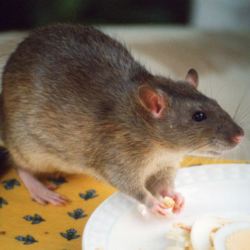I have lived in Manhattan for five years. In that time, I have gotten used to the constant hordes of people, waiting in line for 30 minutes to buy a half gallon of milk, paying $7.00 for said half gallon of milk, and the constant smell of urine (which gets worse in the summer). (1) There is one thing, though, that I have not gotten used to - the rats.
They lurk, hide and scurry and they are everywhere. And, it turns out they don't like to venture far from their neighborhoods.
New work by a group at Fordham University, published in Molecular Ecology, compared the genetic makeup of 262 brown rats (Rattus norvegicus) living in Manhattan. They trapped the rats throughout Manhattan in parks and private properties in areas with evidence of rat activity. Shockingly, a recent survey conducted by the NYC Department of Health and Mental Hygiene (DOHMH) showed that 8.2% of all properties in Manhattan showed signs of rat activity.
The rats were trapped in lethal snap traps. Once killed, their DNA could be isolated from tail clippings and sequenced. The group analyzed 61,401 single nucleotide polymorphisms (SNPs) - changes in the DNA - to asses how genetically close the rats are to one another. This, in turn, told them how closely related the rats are and gave a sense of how much or how little they move around geographically.
It is estimated that rats came to Manhattan between 1750-1770 on ships from Western Europe, particularly France and England. Despite NYC being the melting pot that it is, the DNA from rats of today still closely resembles their earliest European ancestors.
What the analysis of the genetic diversity found is that rats don't move far from where they were born. Within the island, they found two main evolutionary clusters - uptown and downtown Manhattan. In addition, the rats stay even more local than that. It is rare that they even move off of their block.
Regardless of their genetic diversity, or lack thereof, the rats remain a major problem in the city. Mayor de Blasio's administration announced a $32 million neighborhood rat reduction plan this past summer. But, something tells me that the rats will still be around even after the $32 million is long gone. And, even though it won't make me like them any more, at least now we know that, like New Yorkers, the rats are loyal to the neighborhoods that they call home.
(1) Did I mention that I actually love living here?
Source: Matthew Combs, "Spatial population genomics of the brown rat (Rattus norvegicus) in New York City" Molecular Ecology. http://onlinelibrary.wiley.com/doi/10.1111/mec.14437/abstract

